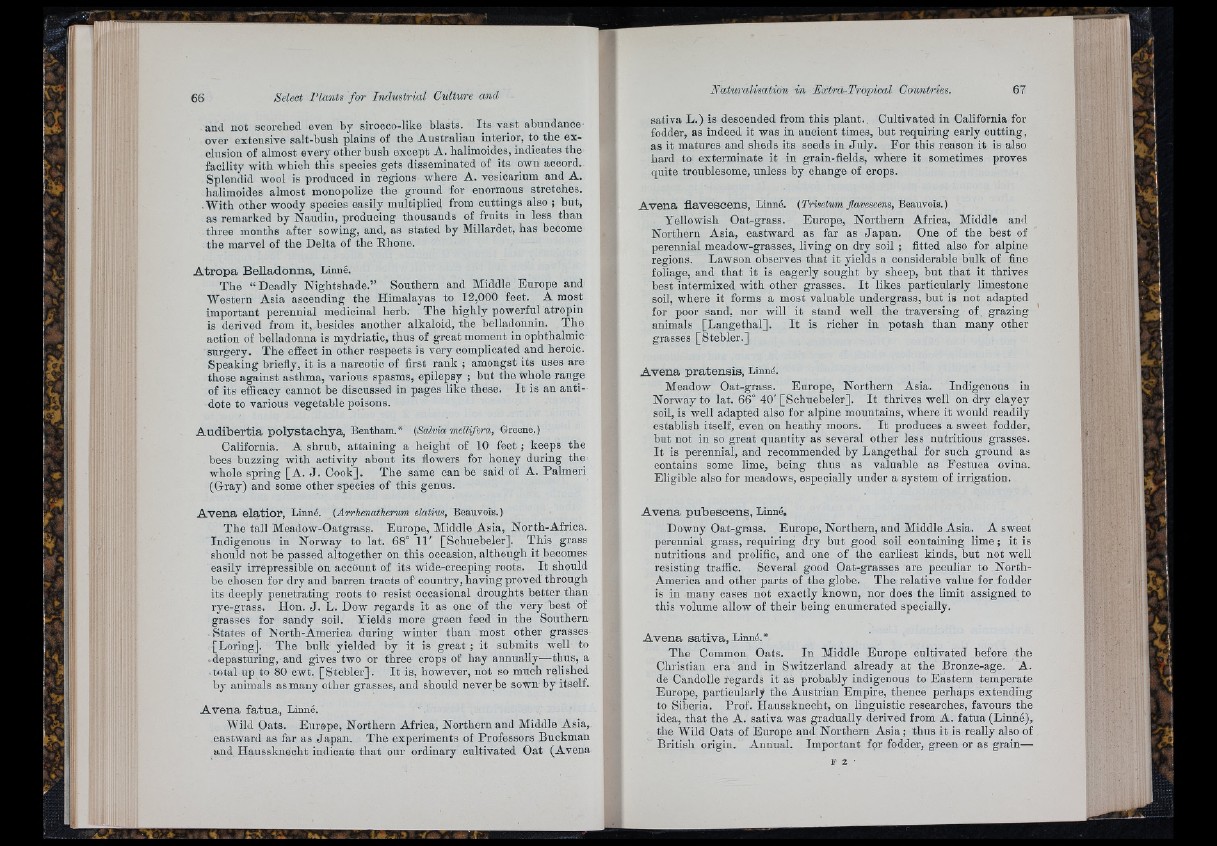
Select Plants fo r Industrial Culture and
and not scorched even by sirocco-like blasts. Its vast abundance'
over extensive salt-bush plains of the Australian interior, to the exclusion
of almost every other bush except A. halimoides, indicates the
facility with which this species gets disseminated of its own accord.
Splendid wool is produced in regions where A. vesicarium and A.
halimoides almost monopolize the ground for enormous stretches.
■ With other woody species easily multiplied from cuttings also ; but,
as remarked by Naudin, producing thousands of fruits in less than
three months after sowing, and, as stated by Millardet, has become
the marvel of the Delta of the Rhone.
A tr o p a B e llad o n n a , Linné.
The “ Deadly Nightshade.” Southern and Middle Europe and
Western Asia ascending the Himalayas to 12,000 feet. A most
important perennial medicinal herb. The highly powerful atropin
is derived from it, besides another alkaloid, the belladonnin. The
action of belladonna is mydriatic, thus of great moment in ophthalmic
surgery. The eifect in other respects is very complicated and heroic.
Speaking briefly, it is a narcotic of first rank ; amongst its uses are
those against asthma, various spasms, epilepsy ; but the whole range
of its efficacy cannot be discussed in pages like these. I t is an antidote
to various vegetable poisons.
A u d ib e r tia p o ly s ta o h y a , Bentham.* (Salvia melUfera, Greene.)
California. A shrub, attaining a height of 10 feet ; keeps the
bees buzzing with activity about its flowers for honey during the
whole spring [A. J . Cook]. The same can be said of A. Palmeri
(Gray) and some other species of this genus.
A v e n a e la tio r, Linné. (Arrhenathemm elatnis, Beauvois.)
The tall Meadow-Oatgrass. Europe, Middle Asia, North-Africa.
Indigenous in Norway to lat. 68° 11' [Schnebeler], This grass
should not be passed altogether on this occasion, although it becomes
easily irrepressible on account of its wide-creeping roots. I t should
be chosen for dry and barren tracts of country, having proved through
its deeply penetrating roots to resist occasional droughts better than
rye-grass. Hon. J . L. Dow regards it as one of the very best of
grasses for sandy soil. Yields more green feed in the Southern
States of North-America during winter than most other grasses
[Loring], The hulk yielded by it is great ; it submits well to
-depasturing, and gives two or three crops of hay annually—thus, a
total up to 80 cwt. [Steb le r]. I t is, however, not so much relished
bj' animals as many other grasses, and should never be sown by itself.
A v e n a f a tu a , Linné.
Wild. Oats. Europe, Northern Africa, Northern and Middle Asia,,
eastward as far as Japan. The experiments of Professors Buckman
aud Haussknecht indicate th a t our ordinary cultivated Oat (Avena
sativa L .) is descended from this plant.. Cultivated in California for
fodder, as indeed it was in ancient times, but requiring early cutting,
as it matures and sheds its seeds in July. For this reason it is also
hard to exterminate it in grain-fields, where it sometimes proves
quite troublesome, unless by change of crops.
A v e n a fla v e s c e n s , Linné, (ynsciam^oerescens, Beauvois.)
Yellowish Oat-grass. Europe, Northern Africa, Middle and
Northern Asia, eastward as far as Japan. One of the best of
perennial meadow-grasses, living on dry soil ; fitted also for alpine
regions. Lawson observes th a t it yields a considerable bulk of fine
foliage, and th a t it is eagerly sought by sheep, but that it thrives
best intermixed with other grasses. I t likes particularly limestone
soil, where it forms a most valuable imdergrass, but is not adapted
for poor sand, nor will it stand well the traversing of grazing
animals [Langethal]. I t is richer in potash than many other
grasses [Stebler.]
A v e n a p ra te n s is , Linné.
Meadow Oat-grass. Europe, Northern Asia. Indigenous in
Norway to lat. 66° 40' [Schuebeler], I t thrives well on dry clayey
soil, is well adapted also for alpine mountains, where it would readily
establish itself, even on heathy moors. I t produces a sweet fodder,
but not in so great quantity as several other less nutritious grasses.
I t is perennial, and reoommended by Langethal for such ground as
contains some lime, being thus as valuable as Festuca ovina.
Eligible also for meadows, especially under a system of irrigation.
A v e n a p u b e s c e n s , Linné,
Downy Oat-grass. Europe, Northern, and Middle Asia. A sweet
perennial grass, requiring dry but good soil containing lime ; it is
nutritious and prolific, and one of the earliest kinds, but not well
resisting traffic. Several good Oat-grasses are peculiar to North-
America and other parts of the globe. The relative value for fodder
is in many cases not exactly known, nor does the limit assigned to
this volume allow of their being enumerated specially.
A v e n a s a tiv a , Linné.*
The Common Oats. In Middle Europe cultivated before the
Christian era and in Switzerland already at the Bronze-age. A.
de Candolle regards it as probably indigenous to Eastern temperate
Europe, particularly the Austrian Empire, thence perhaps extending
to Siberia. Prof. Haussknecht, on linguistic researches, favours the
idea, that the A. sativa was gradually derived from A. fatua (Linné),
the Wild Oats of Europe and Northern Asia; thus it is realty also of
British origin. Annual. Important for fodder, green or as grain—
; r ■
t i l
S t “HA*